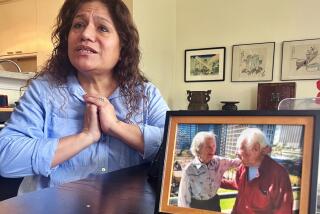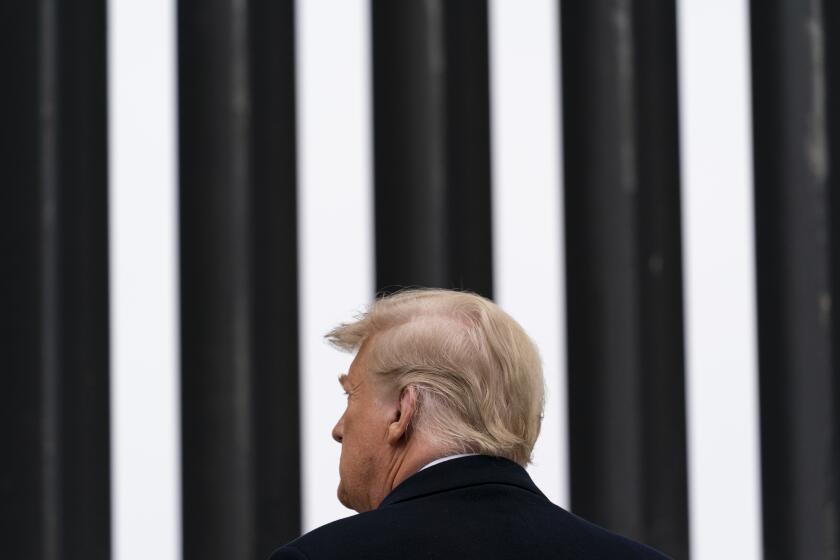Op-Ed: He lived cautiously, and then died suddenly
- Share via
My father did everything “right,” yet there he was in intensive care, on life support. When my teenage daughter Alice asked what had happened to her grandfather, all I could say was, “He was walking Parker,” my sister’s sweet but somewhat unruly Rhodesian Ridgeback, “and he tripped.”
We both knew it wasn’t supposed to happen this way. Grandpa Arthur was “only” 87, and he was following the well-worn path established by his parents and siblings: You live well into your 90s, and then you die in your sleep.
To make matters more confusing, my father slept well, ate well and kept his mind sharp. OK, maybe he didn’t exercise as much as he should have. He was one-half of a cautious couple, maybe compulsively so. My father and mother spent a good deal of their lives reading in the den of their split-level suburban home in Westchester, N.Y., in life-preserving mode: They were reluctant to stay out beyond 8 in the evening, much less travel to parts known or unknown.
Their culture of caution rubbed off on me and, in turn, Alice. We can both be counted on to double-check that all doors are locked at night, to make sure that there are no expired food items in the refrigerator, and verify that all carbon monoxide levels remain sub-lethal. Like father, like daughter. On a daily basis, Alice and I often fight against our natural tendencies, forcing ourselves to be less neurotic and more adventurous.
A quick rewind for a moment to a few years before Arthur tripped. It is a glistening March day, and Alice and I have just arrived at the top of Mammoth Mountain in the Sierra. We are 11,000-plus feet above the height I am most comfortable with: sea level. The air is rarefied and the sky an arm’s length away. Unlike the top of most ski runs, the atmosphere is noticeably tense as skiers and snowboarders skitter around nervously, discussing descent lines and reminding themselves that the best strategy is a basic one: Don’t fall.
We glide 100 yards from the gondola exit to the top of a run aptly called Cornice — as in snow cornice, an overhanging edge. Alice yells through her helmet and goggles, “How are we going to do that?” My parental reassurance is coated in fear: “Don’t worry, sweetie,” I say, “I’m a little scared too.” She asks, “So what do we do?” And in that instance, I am inexplicably relaxed and brave. I lift my poles in the air, arms outstretched and horizontal to the snow and exclaim, “Just hold your breath, and jump.” And we do.
Mountains are static, but death assumes many guises. Dogs are simply put to sleep; people are euthanized, something that sounds clinical, intimidating, foreign. It is a term and a concept that quickly becomes familiar when you are faced with the difficult decision of disconnecting a loved one from life support. My father died within hours of our decision — and his, through his advanced medical directive — to end all life support. All of this unfolded within 30 hours of the fall he took. A quick end to a cautious life lived.
Grief brings with it a torrent of thoughts and emotions. But one clear and simple thought preoccupied me during the weeks immediately following my father’s death: Life is fragile.
After being raised in a cautious household, and radiating the fears stoked by it through to my children, especially my daughter, I found myself influenced by a don’t-let-your-kids-walk-to-school-alone-until-they’re-27 parenting culture. Modern life only compounds my instinct to hunker down and play it safe.
Yet this strategy holds no guarantees. You can consume massive amounts of fruit and vegetables, swallow vitamins by the handful (as my father did), have regular checkups, chest X-rays, EKGs and colonoscopies — and still die because you stumbled and hit your head while walking the dog.
I now recognize that in my late 50s, I still have a chance to reassess the probabilities, analyze the costs and benefits, recalibrate — and decide what risks in life are worth taking. Along the way, I hope to find a few more chances to hold my breath and jump.
Jeffrey Wasserman is vice president and director of Rand Health.
Follow the Opinion section on Twitter @latimesopinion and Facebook
More to Read
A cure for the common opinion
Get thought-provoking perspectives with our weekly newsletter.
You may occasionally receive promotional content from the Los Angeles Times.









